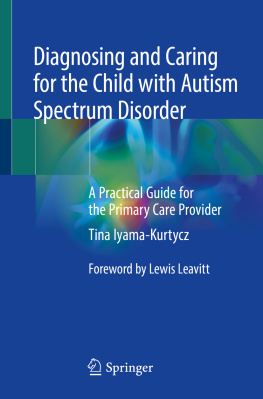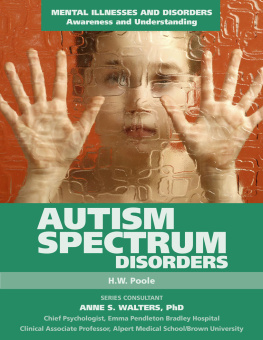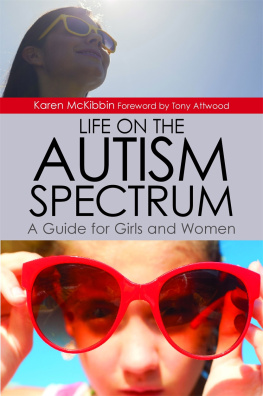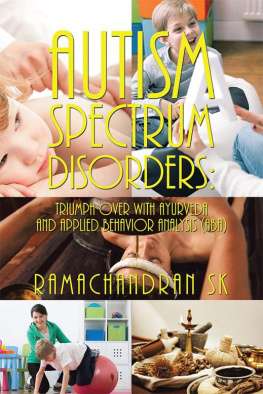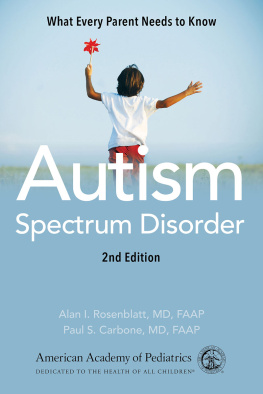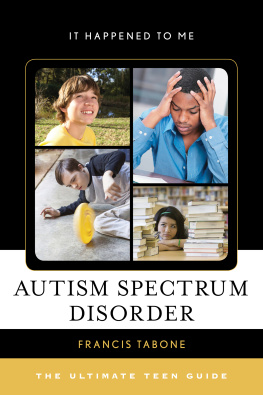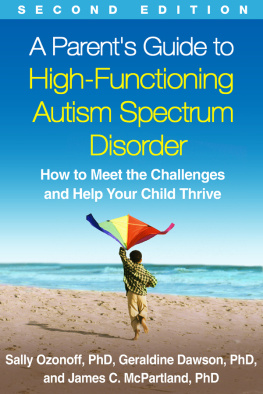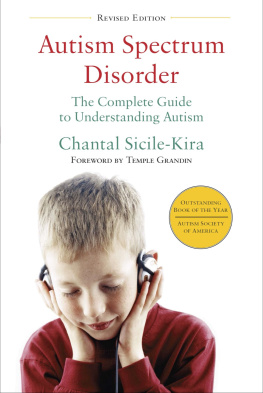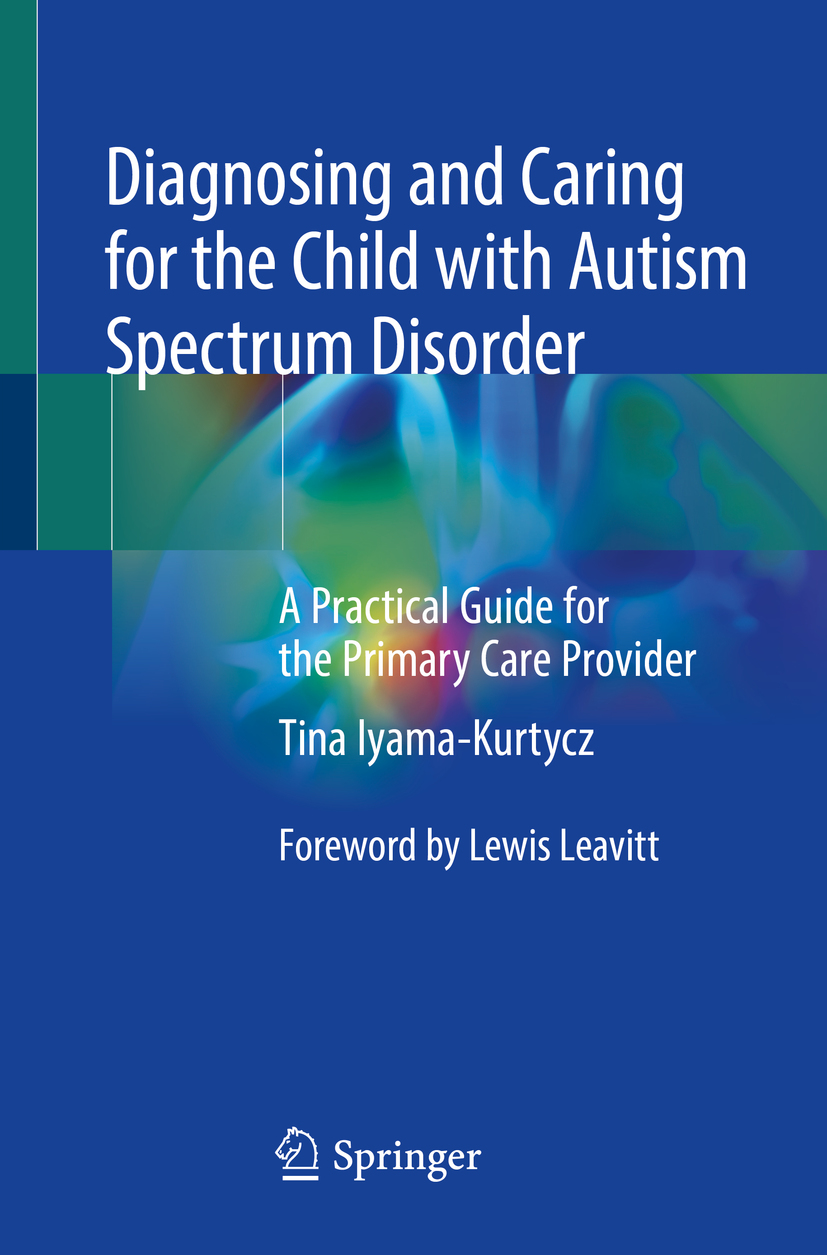Tina Iyama-Kurtycz
Diagnosing and Caring for the Child with Autism Spectrum Disorder
A Practical Guide for the Primary Care Provider
Tina Iyama-Kurtycz MD
Waisman Center, University of Wisconsin System, Madison, WI, USA
ISBN 978-3-030-26530-4 e-ISBN 978-3-030-26531-1
https://doi.org/10.1007/978-3-030-26531-1
Springer Nature Switzerland AG 2020
This work is subject to copyright. All rights are reserved by the Publisher, whether the whole or part of the material is concerned, specifically the rights of translation, reprinting, reuse of illustrations, recitation, broadcasting, reproduction on microfilms or in any other physical way, and transmission or information storage and retrieval, electronic adaptation, computer software, or by similar or dissimilar methodology now known or hereafter developed.
The use of general descriptive names, registered names, trademarks, service marks, etc. in this publication does not imply, even in the absence of a specific statement, that such names are exempt from the relevant protective laws and regulations and therefore free for general use.
The publisher, the authors, and the editors are safe to assume that the advice and information in this book are believed to be true and accurate at the date of publication. Neither the publisher nor the authors or the editors give a warranty, expressed or implied, with respect to the material contained herein or for any errors or omissions that may have been made. The publisher remains neutral with regard to jurisdictional claims in published maps and institutional affiliations.
This Springer imprint is published by the registered company Springer Nature Switzerland AG
The registered company address is: Gewerbestrasse 11, 6330 Cham, Switzerland
To the center of my whole world and the long keel on our boat, Dr. Dan Iyama-Kurtycz
To David and Jonathan, who taught me about parenting, when I knew nothing
Foreword
Over a half century ago as a physician in training, I was confronted by my first patient with autism (now called autism spectrum disorder). It was then considered rare. Knowledge about the etiology, physiology, diagnostic approach, and even terminology was inchoate, confusing, and most importantly not very helpful to the patients or their families. Medical science had few tools and resources to bring into service.
Empirical research over the ensuing decades performed by a wide variety of disciplines has brought a revolution in our understanding of autism and new diagnostic and treatment modalities. A reconceptualization from a rare psychiatric disorder to a neurodevelopment disorder based on altered neurologic function has allowed the development of treatment approaches to ameliorate dysfunctional behavior. It has been one of the rewards of a long career for me to see the repair of many of the negative connotations of autism spectrum disorder (ASD) and to see the positive results of new therapeutic approaches.
All this would be interesting for the primary care provider (PCP) but not of great importance to everyday practice were autism spectrum disorder truly a rare occurrence. However, our new understanding of ASD and careful epidemiological research has shown that ASD occurs in one in 59 children (2018, CDC). This means that every PCP will encounter children with ASD in their practice. Patients with ASD have a considerable burden of physical, psychological, and social concerns. It means that PCPs must think about how to evaluate children with ASD and determine what resources for therapy are available in their community. Providing a medical home for these patients requires PCPs to prepare linkages with appropriate medical, social, and educational resources. This is a big ask.
Even today, most PCPs have had little professional training in ASD. There are now some technical books which review recent work on diagnosis and therapy, but to date, there has not been a practical vade mecum that covers the practical how-to-do-it for the day-to-day work of PCPs in the clinic.
In this book, Dr. Iyama-Kurtycz comes to the rescue. She is ideally suited to the task. She is a developmental pediatrician who has spent decades devoted to the clinical care of children with ASD. Trained in developmental pediatrics and on the faculty of the University of Wisconsin School of Medicine and Public Health for more than 30 years, she has extensive clinical experience working with colleagues in an interdisciplinary academic and clinical setting. She is conversant with the research and practices of a wide range of practitioners from pediatrics to genetics to social work and understands how important it is for a multidisciplinary group to collaborate in the care of children with ASD.
Writing in a conversational style, Dr. Iyama-Kurtycz takes the reader by the hand. She starts with a stroll through current understanding of the disorder and then picks up the pace to provide, step-by-step, practical and concrete ways that practitioners can proceed with their patients. Her advice is meticulously based on research and has been tested in her everyday clinical practice. She is frank about what is easily done, what is hard to do, and what is still simply unknown.
This book will be invaluable to PCPs over and above its coverage of ASD. Many of the techniques of a developmental approach to the evaluation of children with ASD generalize to an approach to all children. Issues like bullying, sexuality, and the importance of friendships, which Dr. Iyama-Kurtycz explains must be addressed with ASD patients, are also important in the lives of all children. The section on working with parents has many practical lessons which generalize to other parent populations.
This is a book about how PCPs can use insights from developmental pediatrics to help their practice be sensitive to variation in the developmental trajectory of children. It will provide enormous practical aid for practitioners and help for the children and families they serve.
Lewis A. Leavitt
Preface
Autism spectrum disorder (ASD) features prominently in our daily world, through print and electronic news sources, books, and movies, and in our personal and professional lives. The information can be scientifically accurate or completely inaccurate. Stories about individuals are not representative of all people with ASD. There is a saying in the autism community that If youve met one person with autism, youve met one person with autism, highlighting how different each person with ASD might be from another.
Everyone who cares for children in a healthcare setting will see children with ASD, and this inundation of autism-related coverage can make understanding ASD seem too confusing, too hard, or too time-consuming.
I wrote this book so that all of you who care for children with ASD can learn enough so that you feel more comfortable in both understanding the condition and caring for your patients. I wrote this book in a style that I hope is very readable, conversational, and accessible. I used real-life stories from my practice to give you the sense of clinical encounters with children and families. This is meant as a practical guide, not a comprehensive review of the literature.
I have lived through the radical change in the understanding of autism. When I started, only the most severe and classic cases of autism were diagnosed. As more and more research emerged, we recalibrated our idea of what autism was and saw who might fit into this clinical box. As we continued to learn, it became clear that there was no diagnostic box but that we were dealing with a spectrum, a spectrum that continues to include more children and adults, who have carried different diagnostic labels.

